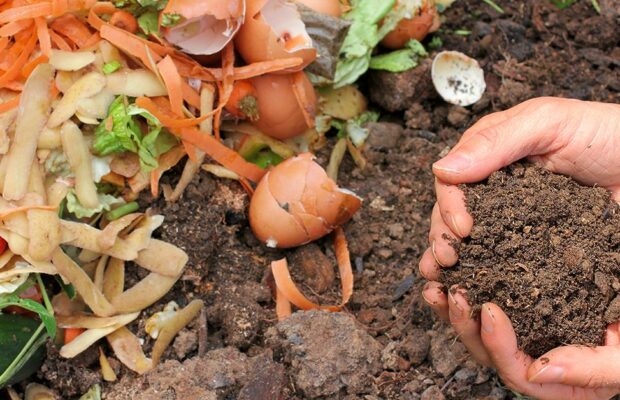Lang introduces composting options in cafeteria

This year for students who are looking to dispose of their waste, composting is the way to go. With the composting bins in the cafeteria, just taking one extra trip down to the cafeteria to get rid of food scraps can contribute to saving the environment.
Biology teacher Jason Lang and some of his students are coordinating the collection of compost. “For our system, everything, every food can be composted, so we don’t need to be picky. It doesn’t need to be the green leafy vegetables. It can be any food. It’s all composted. Along with the food you can also compost napkins, and you can compost the paper bags that people leave in the lunchroom with, so everyone could bring their paper bag back to the lunchroom when they’re done and put those in the compost bins, and that would make perfect compost.”
Lang said, “Right now it’s pretty slow we think for two reasons. We think a good thing is that most people eat all the food that was on their plate, so that’s a really good thing, but we’re probably not getting as many people to bring their food back down to the lunchroom and get those scraps put into the composting bags. People are good at putting napkins in the compost bin, but we need to hopefully take the next step and get the brown paper bags and those extra little bits of scraps of food that are either from the lunchroom or even from the students in the hallways. If they would just make one more trip down and put their food scraps into the compost and the brown paper bag, that would make our level of composting much larger really quickly.”
Lang said the extra effort would have a positive impact on the environment “because what’s gonna happen is this, when we put less food into the garbage, that means that there is less garbage going to the landfill, so that’s a space issue, but the other thing is this: when we put food and other materials that break down into the landfill, over the next hundreds of years, those are going to decompose and release methane into the atmosphere, and methane is a greenhouse gas that is 25 times worse than carbon dioxide, so when we compost, that food will be decomposed, but instead it releases carbon dioxide, which is not perfect. It was going to decompose anyway, so the food, paper and napkins that we compost will be composted into a usable soil that has a lot of nutrients in it. You can blend it into gardens and farm fields. It’s a really positive thing for the environment. All of our food instead of going to the landfill can go into gardens and farm fields to help add to the soil that’s already out there.”
Lang also has tips for people interested in composting. “Here at school, you just gotta get into the habit of doing it, so get in the habit of instead of running very quickly to the garbage because it’s the fast and easy thing to do, pause, and put your napkin and food in the compost bins. If you eat lunch in the hallways, get in the habit of taking a trip back to the lunch room and putting your food waste into the compost bag, and also putting your paper bag into the compost bin. Now if you want to compost at home, the key thing is any compost bin that someone might have at their house. You have to remember you have to put a 3:1 ratio of what we call ‘brown’ or carbon foods and nitrogen foods. If you’re composting at home, you have to remember two things. So you have your salad wastes, which is kinda the brown stuff, but you have to remember that in a home composting bin you cannot put fats, oils and meats. In a big system like we have here at school, those things can be composted because they are being shipped and going through a different process. So if you compost at home, think of your vegetable scraps and then even think of leaves in your yard. This time of year is perfect to gather leaves and those can be part of your composting. Then you throw in maybe some more of the green stuff, a little bit of grass. It’s carbon-based composting, and there’s food that contains nitrogen, and you have to have a low level of nitrogen, a ratio of 1:3. One part nitrogen for every three parts carbon. If you do that, your compost bin will be healthy, won’t smell and after a year or so, you will have usable soil. It just takes time. The problem is that many people add too much of the rich foods with the nitrogen, so their compost bins get really smelly and they stop. The easy solution is to add carbon. Another good way to add carbon is shred your newspaper. Once you add some shredded white paper, that becomes your carbon. That will override the richer nitrogen foods.”
Senior Maya Mallavarapu said, “I haven’t been as hands on with it as much this year, but I started a composting and recycling program at Holmes Junior High a few years ago, so I was more hands on with that, but I am really happy that Mr.Lang was able to get at least a few composting bins in the cafeteria.
“Every time I’m in the lunchroom I try to sort out my trash and put it in the compost bin down there. You can definitely compost daily in the lunchroom. It just has to be under the list of materials that can be composted.”
Lang invites those interested in learning more about composting or helping to save the environment to talk to him about joining the compost club.









You must be logged in to post a comment Login